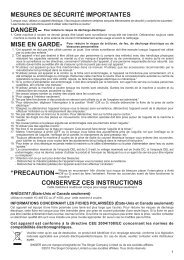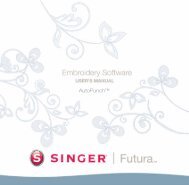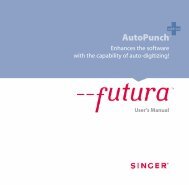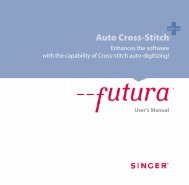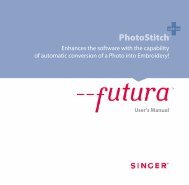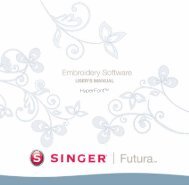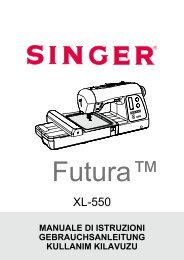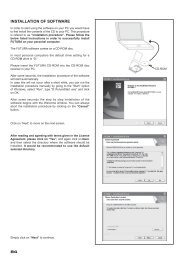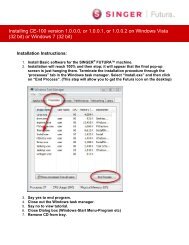1 - SINGER Futura Support
1 - SINGER Futura Support
1 - SINGER Futura Support
- No tags were found...
You also want an ePaper? Increase the reach of your titles
YUMPU automatically turns print PDFs into web optimized ePapers that Google loves.
STRAIGHT STITCHINGThe straight stitch is the stitch most frequently used. Let’s setthe machine for the basic straight stitch.1. SETTINGSPresser foot - General Purpose FootThread tension control - SA. Thread tension controlB. Needle stop position selector switchC. Reverse stitch switchD. Start/stop switch (For embroidery only)E. Feed dog controlF. Presser foot lifterG. Stitch width control leverH. Stitch length controlI. Power/light switch1BCDE2AF4HGI2. Pull both threads under the presser foot toward the back ofthe machine, leaving about 6” (15cm) clear.3. Place the fabric under the presser foot and lower thepresser foot lifter.4. Turn the hand wheel toward you until the needle enters thefabric.5. Start the machine. Guide the fabric gently with your hands.When reaching the edge of the fabric, stop the sewingmachine.536. First turn the handwheel counter clockwise (toward you)until the needle is in its highest position, then raise thepresser foot. Draw the fabric to the rear and cut off excessthread with the thread cutter located on the bottom of theface cover, as shown.6KEEPING SEAMS STRAIGHTTo keep the seam straight, use one of the numbered guidelines on the needle plate. The numbers indicate distance fromthe needle at its center position.The guide line on the bobbin cover plate is 1/4" (6mm) seamguide line which is used for piecing quilt blocks and also fornarrow seams, such as those in doll clothes or baby garments.3/4" (19 mm)5/8" (16 mm)1/2" (13 mm)3/8" ( 9 mm)1/4" ( 6 mm)32



